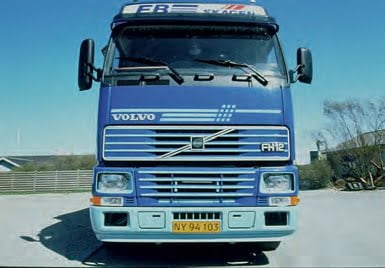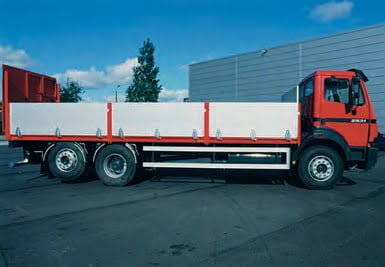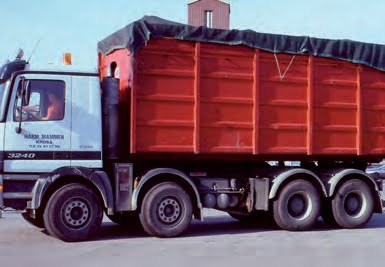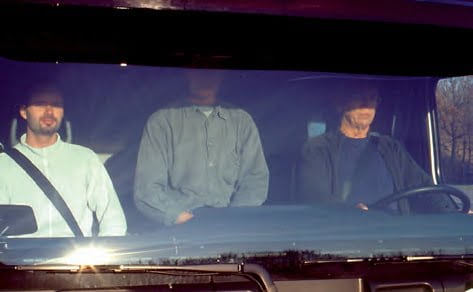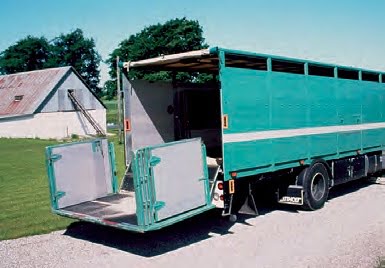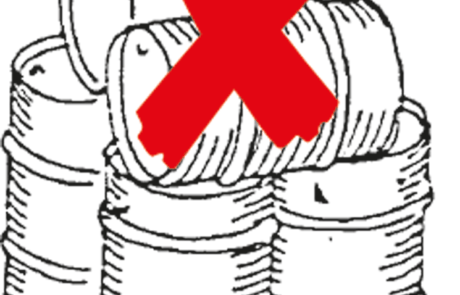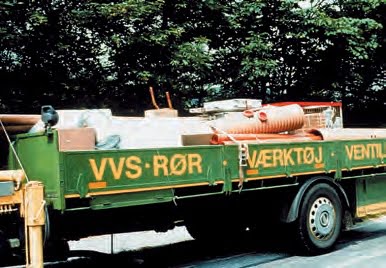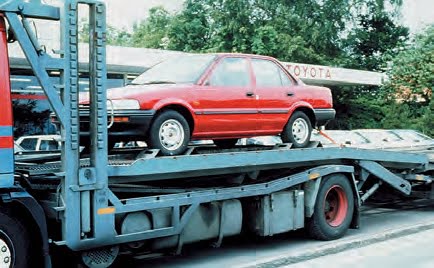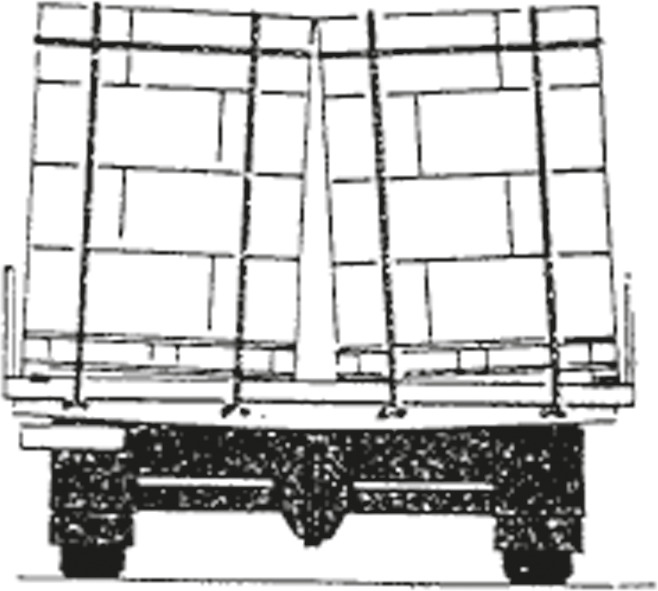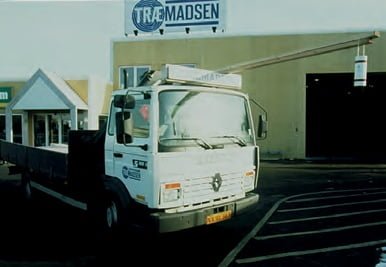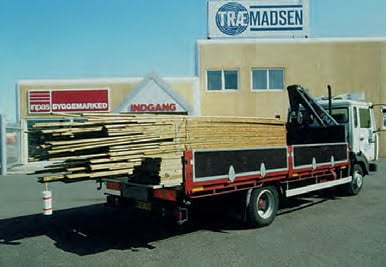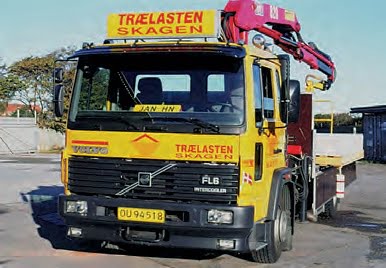large cars
Driving school
theory book
for category C - D - C/E - D/E
Large cars and lorries
9. Vehicle width, length, height and weight.
Before loading the vehicle with goods or passengers, keep the following legal regulations in mind:
Vehicle width
A vehicle with or without a load must not be wider than 2.55 metres; however, refrigerated vehicles with refrigerated boxes that have heavy side walls may be 2.60 metres. The width is measured over the parts that extend furthest to each side, with the exception of, for example, side mirrors and side indicators, etc. When driving a wide vehicle or load on a narrow road, you must pay particular attention to other traffic, keep as far to the right as possible and, if necessary, stop to allow others to pass.
Vehicle length
A car, with or without a load, may not be longer than 12 metres. A BUS can have a length of up to 13.5 metres. Three-axle buses can have a length of up to 15 metres. Articulated bus 18.75 metres. The length is measured over the parts that extend furthest forwards and backwards. Except for e.g. coupling devices. When driving with loads that extend more than 2 metres beyond the front of the vehicle, the driver must have a helper who can get out of the vehicle and guide the driver and warn other road users at junctions, railway crossings and similar difficult places.
Vehicle height
A car, with or without a load, must not be higher than 4.10 metres. The height is measured from the carriageway to the highest part of the vehicle. Except for antennae, for example. Even if the height of the vehicle is less than 4 metres, you must ensure that you can drive under bridges, wires and the like without danger or inconvenience. Ice, fog or rain can cause wires and any decorations to hang low.
Vehicle weight
When loading a vehicle, its permissible gross vehicle weight and axle load must not be exceeded; therefore, it is necessary to know the following:
Shaft pressure
The car's axle load is the pressure transferred to the road from the wheels on that axle or bogie. The maximum permissible axle load is usually 10 tonnes for a single axle.
Cars in international traffic may have a permitted drive axle load of up to 11.5 tonnes if the drive axle is fitted with twin wheels and road-friendly suspension. The total weight of a car must not exceed the sum of the axle loads permitted for the vehicle. Vehicles authorised for international traffic must comply with national weight limits when used in national traffic only.
Permissible total weight
The permissible gross vehicle weight is the maximum authorised weight of the vehicle with operating equipment, driver and load at the time of registration. The vehicle's permissible gross vehicle weight, axle load and load are stated in the registration certificate.
Actual gross vehicle weight
The instantaneous weight of the vehicle with operating equipment, driver and load. This weight is important, for example, for sightless coupling and for some traffic signs that prohibit driving with vehicles above a specified actual weight.
Inscriptions
Vehicles must be labelled on both sides with an inscription indicating the maximum permissible total weight (T) and the maximum permissible load (L). The load includes the weight of the driver, passengers, fuel, oil, water and tools.
T 18000
L 10000
or, instead of L (load), NL (payload) can be entered. For new vehicles, a new term (kerb weight) is used, i.e. the unladen weight of the vehicle including the weight of the driver (75 kg), oil, water and fuel.
T 18000
NL 9400
Other legal provisions:
The total weight of a car must not exceed the following limit:
- Car with 2 axles: 18 tonnes.
- Car with 3 axles: 24 tonnes, but up to 26 tonnes in international traffic.
- Car with 4 or more axles: 29.5 tonnes or, if special requirements are met, 32 tonnes.
- Ledbus 3 axles: 28 tonnes.
- Ledbus 4 axles: 34 tonnes.
Dispensations:
The police can authorise exceeding the maximum width, length and height limits for vehicles if it is difficult to transport goods in any other way. The police's written authorisation must be carried during the journey. The authorisation may contain more detailed conditions for the transport, such as time, route and police escort.
Block trolley
You may only drive a loaded articulated lorry with a police permit. The licence must be carried during transport. The same applies to driving with a mobile crane.
People and goods
Legal regulations for the positioning of people and goods and the labelling of goods to remember:
Persons and goods must be positioned so that the driver has a clear view and sufficient opportunity to use the vehicle's controls, instruments and mirrors. Fitted seat belts must be used. No more people may be transported in the lorry than the number of seats with seat belts. This does not apply to older lorries where seat belts are not fitted. The obligation to use seat belts does not apply when reversing or when driving in a car park, service station, workshop area or under similar conditions.
Goods must not cover indicators, lights and licence plates, make unnecessary noise, create smoke or dust to a disturbing extent, drag or fall on the road or otherwise obstruct or endanger traffic. If something is dropped or spilled on the road and this may cause some risk to other road users, it must be removed immediately. If this is not possible, warn others as best you can, e.g. by stopping the vehicle and switching on the hazard warning lights until help is called. In the event of loss or spillage of hazardous substances, take the precautions mentioned in the written instructions provided.
Animal transport
The transport of animals is subject to special regulations regarding the layout of the lorry. They must be transported in such a way that they are not subjected to unnecessary suffering. They must have sufficient space and ventilation as well as protection from wind, cold, rain and sun. Special provisions apply to the execution of the transport. Lorries to be used for the transport of large animals must be approved for animal transport by an inspection company.
Placement and transport of goods
Safe placement and transport requires knowledge of some general guidelines to keep in mind when transporting goods:
When loading different types of goods, the general rule is that the heaviest should be placed at the bottom of the bed and as close as possible to the centre line of the bed. Furthermore, the goods should be loaded up the front of the vehicle, unless this results in excessive front axle pressure. In this case, the load should be placed in the centre of the load, i.e. slightly in front of the rear axle, and secured by bracing up to the front end. In all cases, however, it must be ensured that at least 20% of the actual total weight rests on the steering axles. For safe loading, attention must be paid to the weight of the goods, how robust and dimensionally stable they are against temperature fluctuations, as well as the strength and moisture resistance of the packaging. For example, wooden slats should be laid on slippery or damp surfaces to prevent the goods from slipping during transport or being affected by moisture. Goods under the category of hazardous substances must be labelled according to international regulations and stowed according to special rules. Vehicles on loads must be secured by applying the parking brake. In addition, the vehicle's wheels must be secured with blocks or wedges and lashings. Drums, barrels and similar rolling goods should be loaded upright as far as possible and otherwise secured against rolling and sliding forwards with blocks or wedges and lashings. Bracing is necessary if the front, side and rear tyres cannot withstand the pressure of the goods when shifting during travel.
Piece goods should normally be secured against shifting with e.g. hooks or straps and by filling gaps, protective pads, corrugated cardboard, blankets or similar.
Stones, gravel, etc. must be secured against falling off during transport. (If the material is dusty/smoking/polluting, it must be covered with a tarpaulin).
Tarpaulins cannot be used for securing or lashing, but are only used for protection against wind and weather. The tying of the tarpaulin must be done in such a way that the wind prevents the tarpaulin from inflating, loosening or causing it to flap for other road users.
High palletised goods should be loaded so that they lean slightly inwards towards the centre from both sides.
You should check the following conditions:
- That any tarpaulin is tightened.
- Any cargo is securely positioned and fastened.
Labelling of goods
- Goods that extend more than 1 metre beyond the front and rear of the vehicle or more than 15 cm beyond the side of the vehicle must be marked.
- The goods are marked with a white cylinder with at least two red reflective stripes. The cylinder must be at least 30 cm high and have a diameter of at least 10 cm.
- However, for non-commercial transport of goods outside of the headlight switch-on time, the marking can be done with a light-coloured cloth or similar. Typically private buses and small lorries.
- In addition, during the headlamp lighting period, all transport must be marked with lights that shine red to the rear and white to the front, clearly visible from a distance of at least 300 metres.
- The marking must be placed on the part of the goods that extends furthest beyond the vehicle and as low as possible, but not lower than 35 cm. The marking must also be positioned so that the driver has sufficient visibility and so that it does not endanger other road users.
Test your knowledge
Cat. C - D - C/E - D/E - D/E - Section 9
Select the questions you think are the right ones.
